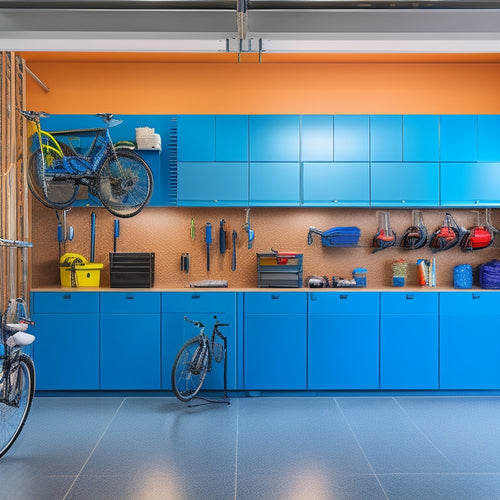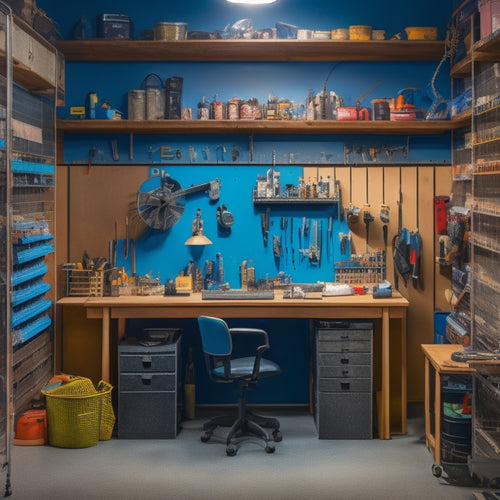
Customize Your Key Storage for Woodworking Success
Share
You'll greatly enhance your woodworking productivity by designing a customized key storage system that caters to your specific tool requirements, accessibility needs, and personalized workflow. Start by designating a specific area for key storage and ensuring frequently used tools are readily accessible. Consider key capacity and tool usage frequency when creating a customizable key storage plan. Choose from pegboards, slatwall panels, and modular cabinetry to create an efficient key storage solution. By streamlining your key access system, you'll save time and optimize your workshop's workflow. Now, take the next step in optimizing your key storage system to maximize your full woodworking potential.
Key Takeaways
• Designate a specific area for key storage to optimize workshop organization and efficiency.
• Utilize customizable key storage plans that consider key capacity, tool usage frequency, and available space.
• Implement a spatial layout that incorporates the 'golden triangle' concept for efficient tool placement and workflow.
• Label and categorize keys efficiently using a system that suits personal preferences and project requirements.
• Streamline key access systems by assigning specific labels and designating a spot for each key to save time and reduce frustration.
Maximizing Workshop Organization Potential
To maximize your workshop's organization potential, start by designating a specific area for key storage, ensuring that frequently used tools and equipment are readily accessible and easily identifiable.
This pivotal placement will greatly enhance your workshop flow, allowing you to quickly locate the tools you need without wasting precious time searching for them. A well-thought-out spatial layout is essential in achieving this efficiency.
Consider the 'golden triangle' concept, where your most frequently used tools are positioned within easy reach, forming the points of a triangle around your workstation. This layout enables you to move seamlessly between tasks, reducing fatigue and increasing productivity.
Customizable Key Storage Plans
With your workshop's layout optimized, you can now create customizable key storage plans tailored to your specific woodworking needs, ensuring that every tool has a designated home and is easily accessible when you need it.
This is where you get to decide how you want to organize your keys, taking into account the unique requirements of your woodworking projects. Consider the key capacity you need - how many tools do you have, and how often do you use them? Do you have a lot of long, bulky tools that require more space, or are most of your tools compact and lightweight?
When creating your plan, prioritize plan flexibility. You never know when you'll need to add a new tool or adjust your workflow. A customizable plan allows you to make changes as needed, ensuring your key storage system remains efficient and effective.
Think about the layout of your workshop, too - where do you tend to work on projects, and where do you need quick access to tools? By considering these factors, you can design a key storage plan that streamlines your workflow and boosts your productivity.
Efficient Key Storage Solutions
You can choose from various efficient key storage solutions, including pegboards, slatwall panels, and modular cabinetry, each designed to maximize your workshop's storage capacity and minimize tool retrieval time. These solutions are tailored to help you optimize your workflow, ensuring that your tools are neatly organized and easily accessible.
A key cabinet, for instance, provides a centralized location for storing and managing your keys, keeping them secure and protected from unauthorized access. Consider integrating digital locking mechanisms for added security and convenience. With a digital lock, you can set personalized access codes or use biometric authentication, ensuring that only authorized individuals can access your valuable tools and equipment.
When selecting an efficient key storage solution, consider the specific needs of your workshop. Assess the types of tools you need to store, the available space, and your personal preferences. By doing so, you can create a customized system that streamlines your workflow, reduces clutter, and boosts productivity.
With the right key storage solution in place, you'll be able to focus on what matters most – creating exceptional woodworking pieces that showcase your skills and creativity.
Tool Organization Made Simple
As you set out to organize your tool collection, you'll want to focus on three critical areas: creating a well-stocked tool station, designing a functional workshop layout, and implementing efficient storage systems.
By prioritizing these elements, you'll be able to streamline your workflow and maximize your productivity.
Tool Station Essentials
Organizing your tool station efficiently hinges on incorporating essential components that streamline workflow and reduce downtime. You'll want to focus on Station Ergonomics, ensuring your workspace is tailored to your body and work style. This means positioning tools and equipment within easy reach, minimizing bending, and optimizing your stance to reduce fatigue.
A well-designed station will help you stay focused and productive.
Next, consider Tool Aesthetics – the visual appeal of your station. A clutter-free and organized space not only boosts productivity but also enhances your overall woodworking experience. Invest in a pegboard or tool holders that keep frequently used tools within easy reach.
Labeling your tools and supplies will also help you quickly identify what you need, saving you time and effort. By incorporating these essentials, you'll create a tool station that's both functional and visually appealing, allowing you to work efficiently and effectively.
With a well-organized station, you'll be able to tackle projects with confidence, knowing that your tools and supplies are always within reach.
Workshop Layout Ideas
Designing a well-structured workshop layout revolves around strategically allocating zones for specific tasks, making sure that each area efficiently supports your workflow. You'll want to create distinct zones for tasks like cutting, sanding, and assembly, each with its own set of essential tools and supplies.
Consider the corner workflow, where you can optimize space by placing frequently used tools and materials within easy reach. This will save you time and energy in the long run.
When deciding on island placement, think about the workflow patterns you've established. Place your island in a way that allows you to move freely between tasks, minimizing walking distances and maximizing productivity. Make certain that your island is equipped with the necessary tools and storage for the tasks you'll be performing in that zone.
Efficient Storage Systems
You'll need a well-thought-out storage system to keep your tools and materials within easy reach, ensuring that your newly designed workshop layout stays functional and clutter-free. Efficient storage systems are important for woodworking success, as they save you time and reduce frustration.
To optimize your storage, consider pegboard optimization. Install pegboards on walls or on the back of doors to hang frequently used tools, such as hammers, screwdrivers, and pliers. This will keep them organized and within reach.
Modular shelving is another effective storage solution. These shelves can be customized to fit your specific needs, providing ample storage for materials, equipment, and supplies. Look for shelving units with adjustable shelves and bins to maximize storage capacity.
Additionally, consider using stackable bins and containers to store small items like nuts, bolts, and screws. By implementing these storage solutions, you'll be able to quickly locate the tools and materials you need, allowing you to focus on your woodworking projects.
With a well-designed storage system, you'll work more efficiently and effectively, leading to better results and increased productivity.
Streamlining Key Access Systems
When you're setting up your key access system, you'll want to prioritize simplicity and efficiency. By simplifying your key organization, you'll reduce the time spent searching for the right key and minimize the risk of misplacing or losing them.
To achieve this, you'll need to optimize your storage layout, ensuring that each key has a designated spot and is easily accessible when you need it.
Simplify Key Organization
Streamline your key access systems by categorizing and labeling your keys according to their corresponding locks, tool functions, or project phases, ensuring that the right key is always at your fingertips. This approach helps eliminate key clutter and saves you time and frustration when searching for the correct key.
By implementing a labeling system, you can easily identify which key corresponds to which lock or tool. This is particularly useful when working on multiple projects simultaneously. Consider using a color-coding system or alphabetical labeling to further simplify your key organization.
Here's an example of how you can categorize your keys:
| Category | Label |
|---|---|
| Tool Keys | Drill Press, Table Saw, Router |
| Project Keys | Cabinet Doors, Drawer Handles, Shelf Pins |
| Lock Keys | Workshop Door, Toolbox, Storage Cabinet |
| Machine Keys | Lathe, Mill, Grinder |
| Miscellaneous | Office Door, Filing Cabinet, Desk Drawer |
Optimize Storage Layout
By assigning a designated spot for each key category, you can create a logical storage layout that puts every key within easy reach, minimizing time spent searching and eliminating clutter. This means categorizing your keys by type, frequency of use, or project-specific requirements.
Once you've grouped your keys, optimizing your storage layout for efficient access is crucial. Consider corner utilization by installing key hooks or small shelves in often-wasted corner spaces. This will help keep frequently used keys within easy reach while keeping less-used keys stored away.
To guarantee you can quickly identify the contents of each shelf or compartment, implement shelf labeling. Use labels or signs to indicate the type of keys stored in each area, making it easy to find the right key when you need it.
Additionally, consider using dividers or small bins to separate keys within a shelf, preventing them from getting jumbled and disorganized. By streamlining your key access system, you'll save time and reduce frustration, allowing you to focus on your woodworking projects.
Personalized Key Management Systems
You can take your key organization to the next level with customized key management systems that cater to your specific woodworking needs and preferences. These systems allow you to create a tailored approach to key storage, ensuring that you can quickly locate the right key for the job.
For instance, you can use a key fob with digital labels to identify and categorize your keys. This way, you can assign a specific label to each key, making it easy to distinguish between similar-looking keys. Additionally, you can program the digital labels to display essential information, such as the key's purpose, the tool it accesses, or the project it's associated with.
Frequently Asked Questions
Can I Use a Pegboard for Key Storage in My Woodworking Shop?
You can optimize your woodworking shop's efficiency by repurposing a pegboard for key storage, strategically designing the layout for easy key accessibility, and ensuring frequently used keys are front and center for quick grabs.
How Do I Organize Keys for Specialized Woodworking Tools?
"Unlock the power of precision: categorize your specialized woodworking tools by function, then label each key with its corresponding tool's name, creating a harmonious workflow where every key has its perfect match."
Are There Key Storage Solutions for Small Woodworking Workshops?
You'll find key storage solutions perfect for small woodworking workshops in compact shelves and wall-mounted racks, which optimize space while keeping your specialized tools' keys within easy reach, ensuring efficient workflow and reduced clutter.
Can I Use a Keyless System for My Woodworking Equipment?
Imagine effortlessly accessing your woodworking equipment without fumbling for keys. You can, with a keyless system featuring digital locks and wireless access, allowing you to swiftly switch between tasks and maximize your workshop's productivity.
How Do I Prevent Key Loss in a Busy Woodworking Environment?
You prevent key loss in a busy woodworking environment by assigning a designated station for each key and using visual reminders, like labels or color-coding, to make sure you always return them to their assigned spot.
Related Posts
-

Best Organizing Tools for a Clutter-Free Space
You're on a mission to change your cluttered space into a peaceful oasis, and you're looking for the best organizing ...
-

Top Garage Storage Bins for Organization and Style
You can enhance your garage's style and organization with the right storage bins. Top brands like Rubbermaid, Suncast...
-

3 Key Steps to Streamline Your Workshop Organization
You're likely wasting 30% of your workshop's productivity and profitability due to disorganization, a common problem ...


